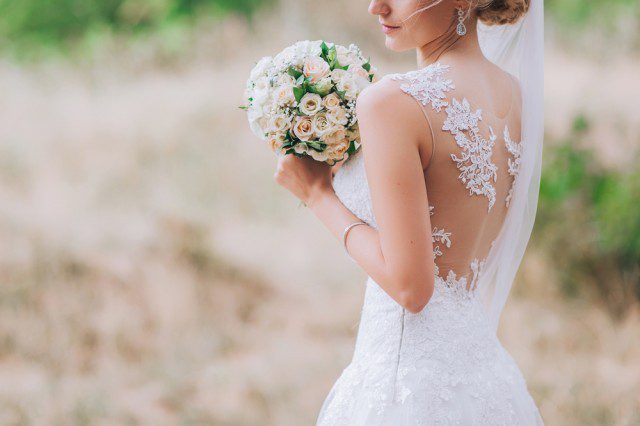The color white has been associated with purity, innocence and virginity for centuries. In many cultures, white is the symbol of a bride’s purity and her worthiness of marriage. For these reasons, wedding dresses are often worn in white by brides on their wedding day.
Wearing a white dress also signifies that the bride is entering into marriage with a clean slate. She has no sexual experience and is therefore pure. The white dress also represents a blank canvas upon which the bride can start her new life with her husband.
It’s a popular belief that the color white symbolizes purity and innocence, which is why brides traditionally wear white on their wedding day. But did you know that there are actually several reasons why wedding dresses are white? Check out these interesting facts:
1. White is a symbol of new beginnings.
A bride wearing white is said to be starting her life with a clean slate. In many cultures, including Hindu and Eastern Orthodox Christian ones, a bride wears red instead of white.
But in Western countries like the United States, Canada, and the United Kingdom, white has become the standard color for bridal gowns.
2. White hides stains well.
Weddings can be messy affairs (just ask any bridesmaid who’s had to help clean up after one!).
A dress made of lighter-colored fabric would show spills and stains more easily than one made of white fabric, which is why many brides opt for a crisp, clean gown in this hue.
3. White makes everyone look good.
Have you ever noticed how good everyone looks in photos taken at winter weddings?
That’s because the stark contrast between black clothes and snowy surroundings creates a slimming effect for everyone in the frame—and since most guests attending weddings wear dark colors anyway, it helps them blend into the background so that all eyes are on the bride in her beautiful white dress!
Why Not Wear a White Wedding Dress
A white wedding dress is a symbol of purity and innocence. It is also a reminder of the bride’s virginity. While there are many reasons to wear a white wedding dress, there are also some good reasons not to wear one.
One reason not to wear a white wedding dress is that it can be seen as outdated and old-fashioned. White dresses were once only worn by virgins or by women who had never been married before. Today, however, more and more brides are choosing to wear colored wedding dresses or gowns with different shades of white.
Another reason not to wear a white wedding dress is that it can be very difficult to keep clean. If you’re planning on having an outdoor ceremony or reception, your dress is likely to get dirty from the grass or dirt. And if you’re getting married in the summer, sweat can also stain your dress.
If you’re looking for something unique and different, you may want to avoid wearing a white wedding dress. You’ll see plenty of other brides wearing white, so why blend in? Consider wearing a colored gown or even black if you really want to stand out from the crowd.
Ultimately, whether or not you choose to wear a white wedding dress is up to you. There are pros and cons to consider, but ultimately it’s your decision!
What Does the Bible Say About White Wedding Dresses?
When planning your wedding, you may be wondering what the Bible has to say about white wedding dresses. The truth is, there is no mention of white wedding dresses in the Bible at all! There are, however, a few passages that mention weddings and marriage in general.
These verses can provide some guidance as you plan your own nuptials.
One passage that may be relevant to your wedding planning is 1 Corinthians 7:2-4. This verse says, “But because of the temptation to sexual immorality, each man should have his own wife and each woman her own husband. The husband should give to his wife her conjugal rights, and likewise the wife to her husband. For the wife does not have authority over her own body, but the husband does. Likewise the husband does not have authority over his own body, but the wife does.”
This verse emphasizes the importance of mutual respect between spouses. As you plan your wedding day and your life together as a married couple, keep this principle in mind.
Another passage that might provide some guidance for your plans is Ephesians 5:22-33.
This section includes verses often read at weddings, such as “Wives, submit to your husbands as to the Lord” (v. 22) and “Husbands, love your wives” (v 33). But this section also contains some less often quoted verses about marriage being a metaphor for Christ’s relationship with the Church. Verses 25-27 say,” Husbands ought to love their wives as their own bodies…This mystery is profound…however let each one of you love his wife as himself.”
These verses emphasize that marriages should reflect Christ’s sacrificial love for us. As you make plans for your big day, keep this image in mind and strive to create a marriage that points others towards Jesus Christ.
Ultimately, there is no definitive answer from Scripture on what color wedding dress you should wear or what specific details you should include in your ceremony or reception plans.
What Does a White Dress Symbolize
A white dress is often seen as a symbol of purity, innocence, and new beginnings. For many brides, a white wedding dress is seen as the epitome of romanticism and is chosen to represent the start of their new life together. In Western cultures, white is also generally associated with positive things like hope and happiness.
However, it’s important to note that the meaning of a white dress can vary depending on cultural context. In some cultures, white is actually associated with death and mourning. So, if you’re considering wearing a white dress for any special occasion, it’s always a good idea to do some research beforehand to make sure you’re not inadvertently sending the wrong message!
What Color were Wedding Dresses before White
In the Western world, white wedding dresses are seen as the norm. But it wasn’t always this way. In fact, before the Victorian era, brides would often wear their best dress – regardless of color.
It was only after Queen Victoria wed Prince Albert in a white gown in 1840 that white became associated with weddings.
Before Queen Victoria’s reign, wedding dresses were often colorful affairs. Reds and greens were popular choices (likely because they were considered good luck), but blues and yellows were also seen occasionally.
After Victoria’s wedding, though, white quickly became the go-to color for brides.
Interestingly enough, Queen Victoria wasn’t actually the first royal to wear a white wedding dress. In fact, both Mary I of England and Maria Theresa of Austria worewhite gowns when they married.
However, it was Victoria’s high-profile wedding that really solidified the association between whiteness and weddings.
So why did white become the standard? For one thing, it symbolized purity and virginity (which was important to Victorians).
White was also seen as a sign of wealth and extravagance – something that many brides aspire to on their big day. Finally, white is just a classic color that looks good on everyone!
Can I Wear a White Wedding Dress If I’M Not a Virgin
Yes, you can wear a white wedding dress if you’re not a virgin. There’s no rule that says only virgins can wear white on their wedding day. In fact, many brides choose to wear white even if they’re not virgins.
So go ahead and pick out the perfect white dress for your big day!
Wearing a White Wedding Dress
A white wedding dress is a long-standing tradition in the Western world. While the color white symbolizes purity and innocence, it is also considered to be a blank canvas that you can embellish with your own unique style. Whether you are opting for a traditional gown or something more modern, there are endless ways to make a white dress your own.
Here are some tips on how to wear a white wedding dress:
1. Choose the right fabric. Silk, tulle, and lace are all popular choices for white wedding dresses.
Consider the climate of your wedding location and select a fabric that will keep you comfortable throughout the day.
2. Accessorize wisely. A veil is a classic choice, but don’t feel limited by tradition – experiment with different headpieces to find what suits you best.
When it comes to jewelry, less is usually more – opt for dainty pieces that won’t overpower your look.
3. Add a pop of color. If you’re looking to add some personality to your outfit, consider adding a colored sash or belt around your waist.
You can also carry a colorful bouquet or wear nontraditional shoes in an eye-catching hue.
4. Consider the silhouette. There are many different silhouette options available when it comes to white dresses – from fit-and-flare to mermaid styles, there’s sure to be one that flatters your figure perfectly!
Try on several different types before making your final decision.
5 Have fun with it! Remember, this is YOUR big day – so make sure you choose a dress that makes you feel confident and beautiful!
Alternatives to White Wedding Dresses
When it comes to wedding dress colors, white is still the most popular hue. But more and more brides are thinking outside the box and choosing alternative hues for their big day. Here are a few of our favorite alternatives to white wedding dresses:
Blush: Blush is a beautiful, romantic color that can work for any season. It’s also a great option if you want something that will stand out in photos.
Blue: Blue is another popular choice for non-white wedding dresses.
It’s perfect for summer weddings and can be very striking in photos.
Silver: Silver is a glamorous option for bride who want something a little different. It’s perfect for an evening wedding or reception.
Gold: Gold is another great choice for an evening wedding or reception. It’s elegant and luxurious, and sure to make you feel like royalty on your big day!
Why are Wedding Dresses White Joke
A wedding dress is typically white because it symbolizes purity. In many cultures, brides wear white to represent their virginity. While this may be the case for some brides, others choose to wear white simply because they love the color or think it looks best on them.
Regardless of the reason, there’s no denying that a white wedding dress is a timeless choice that will always be in style.
/sq-0aff8b108dee456fafa106076608f3b2.jpg)
Credit: www.brides.com
Are Wedding Dresses Supposed to Be White?
The white wedding dress is a time-honored tradition that is steeped in history and symbolism. While the white gown is now seen as the standard bridal look, it was not always this way. In fact, the tradition of the white wedding dress is relatively new, dating back to the Victorian era.
Wedding dresses were actually often colorful and reflective of the fashionable trends of the day during most of history. It was Queen Victoria’s choice to wear a white gown when she married Prince Albert in 1840 that began the trend of white weddings. The couple’s marriage was considered to be a true love match and their nuptials were highly publicized and copied throughout Europe.
Soon, wearing a white wedding dress became a symbol of purity and innocence for brides all over the world.
Today, there are no hard and fast rules about what color your wedding dress should be. While many brides still choose to stick with tradition and go for a classic white gown, an increasing number are opting for dresses in different colors or even patterns.
Whether you decide to go traditional or take a more modern approach, ultimately it is up to you – after all, it is your big day!
When Did White Become the Color for Wedding Dresses?
The tradition of a bride wearing white on her wedding day has been around for centuries, and the reasons for this are varied. In some cultures, white is seen as a symbol of purity and innocence, while in others it is representative of new beginnings. Whatever the reason, the white wedding dress has become an enduring symbol of nuptials worldwide.
The earliest recorded instance of a bride wearing white dates back to the 1406 marriage of Philippa de Roet to John of Gaunt. Queen Philippa was noted for her impeccable taste, and she is credited with popularizing the white gown among European royalty. From there, it wasn’t long before upper-class brides began donning white dresses on their big days.
It wasn’t until much later that white became the standard color for all brides, regardless of social class. This shift is often attributed to Queen Victoria’s choice to wear a white gown when she wed Prince Albert in 1840. The royal couple’s highly publicized nuptials helped to solidify white as the go-to hue for weddings.
In recent years, more brides have begun straying from tradition by opting for non-white wedding dresses. While this trend is still relatively uncommon, it’s safe to say that the allure of a classic white gown will continue to hold strong for generations to come.
How Did the White Wedding Dress Tradition Start?
The white wedding dress has been a symbol of purity and innocence since Queen Victoria popularized it in the 1800s. While the color white has always been associated with purity, it was not until the Victorian era that brides began to wear white gowns on their wedding day. Prior to that time, brides simply wore their best dress, which could be any color.
Queen Victoria is credited with starting the trend of wearing a white wedding dress when she wed Prince Albert in 1840. She chose to wear a simple white lace gown, which was considered quite scandalous at the time. White was not only an uncommon color for weddings, but also for everyday attire.
Wearing such a bold color on her wedding day made quite a statement.
Since then, the tradition of wearing a white wedding dress has continued and evolved. Today, there are many different styles of white dresses available to choose from.
Whether you want a simple and elegant gown like Queen Victoria’s or something more modern and flashy, you’re sure to find the perfect dress to suit your style.
Why Are Wedding Dresses White? | Jill Maurer
Conclusion
In Western cultures, the color white is often associated with purity, innocence, and virginity. For many brides, wearing a white wedding dress is seen as a symbol of their chastity and commitment to their marriage. While the tradition of wearing a white wedding dress is not as old as some people think (it only became popular in the Victorian era), it has become an enduring symbol of weddings in many cultures around the world.
There are several reasons why wedding dresses are typically white, including the associations mentioned above as well as the fact that white is a relatively neutral color that goes well with most skin tones.







